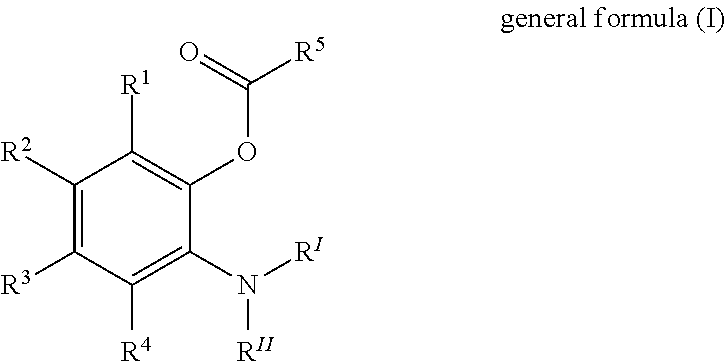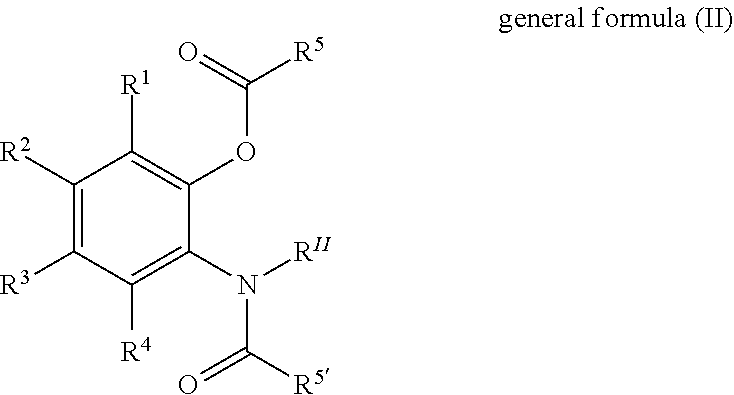Solid catalyst component for use in olefin polymerisation, catalyst, and application thereof
a solid catalyst and olefin polymerisation technology, applied in the field of solid catalyst components, can solve the problems of poor activity of the diol ester catalytic system and the poor stereoregularity of pp and the hydrogen sensitivity of the catalyst, and achieve the effect of strong coordination effect, high activity of the obtained catalyst, and active and effective role in the activity and isotacticity of the catalys
- Summary
- Abstract
- Description
- Claims
- Application Information
AI Technical Summary
Benefits of technology
Problems solved by technology
Method used
Image
Examples
examples 2-49
[0143]The solid catalyst component was prepared as in Example 1, except that the 2-benzamide-phenyl benzoate was replaced in the order of the compounds in Tables 1 to 3, respectively.
example 50
[0144]To a 500 ml of fully nitrogen-purged five-necked flask equipped with a stirrer were added 10 g of MgCl2·3C2H5OH microspheres and 150 mL titanium tetrachloride at −15° C. to prepare a suspension, and then the system was kept at −15° C. for 1 hour and warmed to 80° C., 3 g 2-[N-benzoyl-N-benzyl]-4-tert-butyl-phenyl benzoate was added, and then the system continued to be warmed up to 110° C. and maintained the temperature constant for 1 hour, then the liquid was cleaned by filter pressing and filtered, the resulting solid was washed 3 times with 120 mL titanium tetrachloride at 125° C. The resulting solid was washed four times with 150 mL hexane at 60° C., after filtering to remove the liquid and drying the solid, a solid catalyst component was obtained.
example 51
[0145]8 g anhydrous magnesium chloride, 38 mL decane and 35 mL 2-ethylhexanol were reacted at 130° C. for 2 hours to form a homogeneous solution. 1.7 g phthalic anhydride was added to the solution, and stirred for 1 hour at 130° C. to completely dissolve phthalic anhydride in the homogeneous solution. The resulting homogeneous solution was cooled to room temperature and was dropwise added to 200 mL titanium tetrachloride kept at −20° C. over 1 hour; After addition was completed, the mixed solution was heated to 110° C. over 4 hours, when the temperature reached 110° C., 3 g 2-[N-benzoyl-N-benzyl]-4-tert-butyl-phenyl benzoate was added, the mixture was stirred at that temperature for 2 hours. After reaction, the solid portion was collected by hot filtration. The solid portion was suspended in 275 mL titanium tetrachloride and reacted at 110° C. for 2 hours. After the reaction, the solid was collected by hot filtration, sufficiently washed with decane and hexane at 110° C., followed b...
PUM
| Property | Measurement | Unit |
|---|---|---|
| molar ratio | aaaaa | aaaaa |
| molar ratio | aaaaa | aaaaa |
| molar ratio | aaaaa | aaaaa |
Abstract
Description
Claims
Application Information
 Login to View More
Login to View More - R&D
- Intellectual Property
- Life Sciences
- Materials
- Tech Scout
- Unparalleled Data Quality
- Higher Quality Content
- 60% Fewer Hallucinations
Browse by: Latest US Patents, China's latest patents, Technical Efficacy Thesaurus, Application Domain, Technology Topic, Popular Technical Reports.
© 2025 PatSnap. All rights reserved.Legal|Privacy policy|Modern Slavery Act Transparency Statement|Sitemap|About US| Contact US: help@patsnap.com



